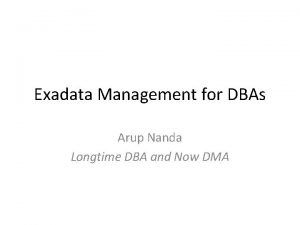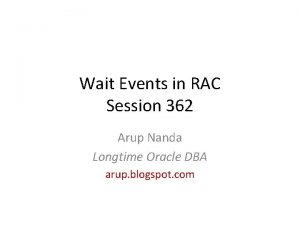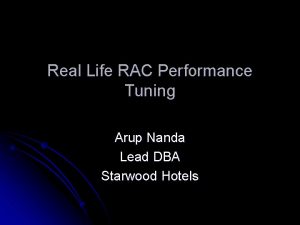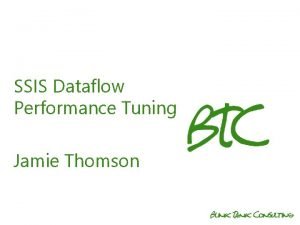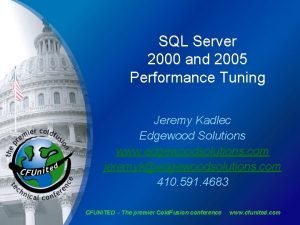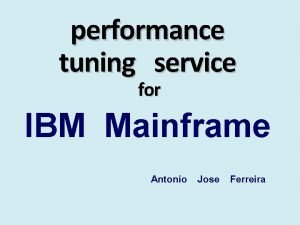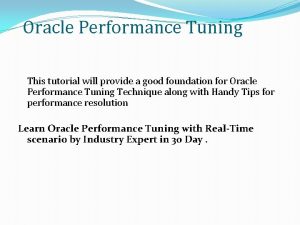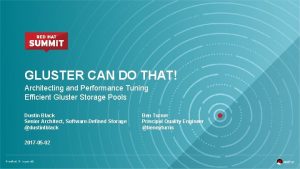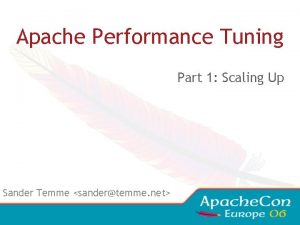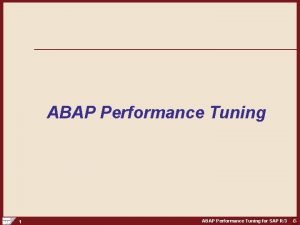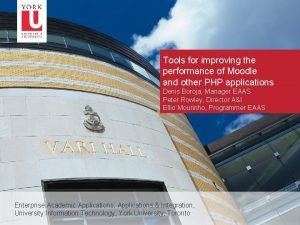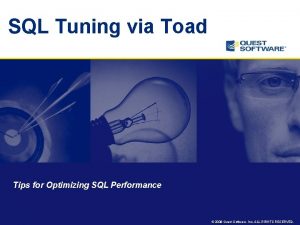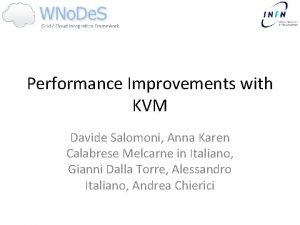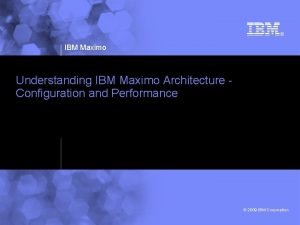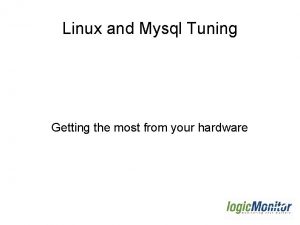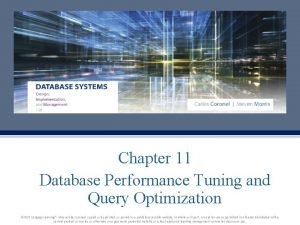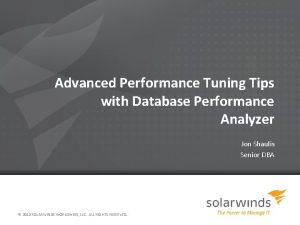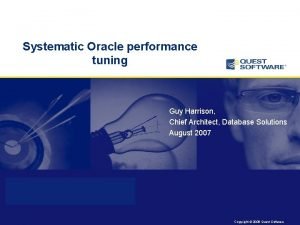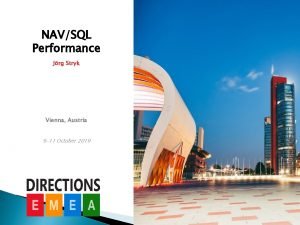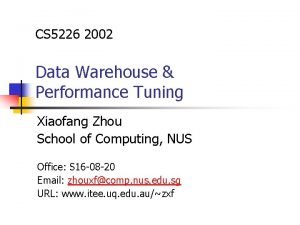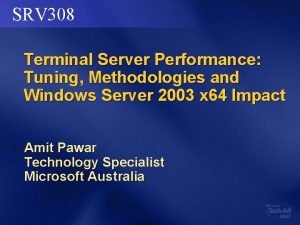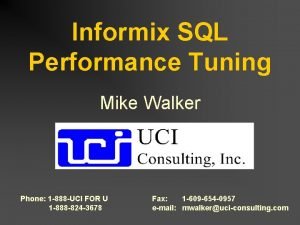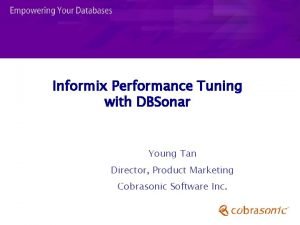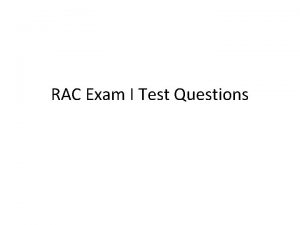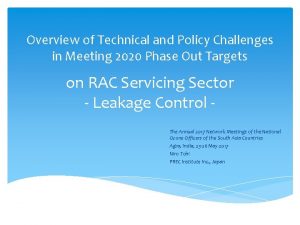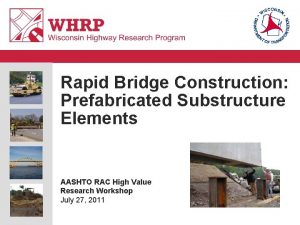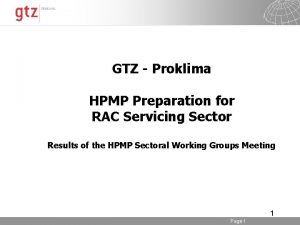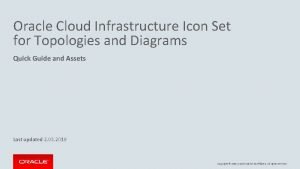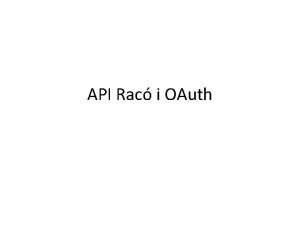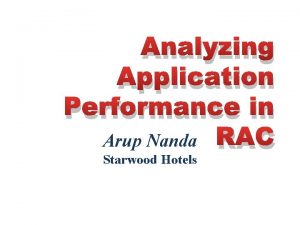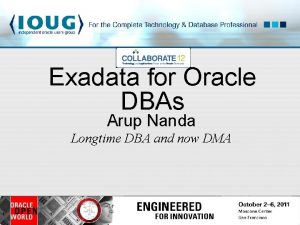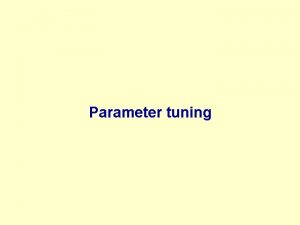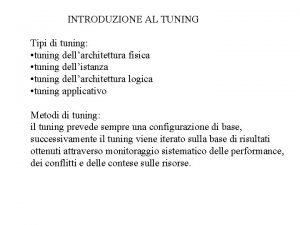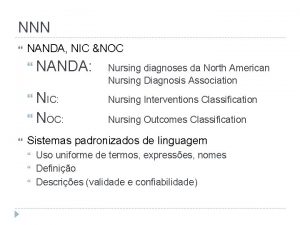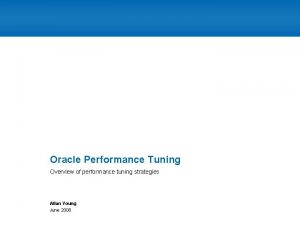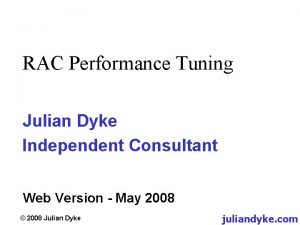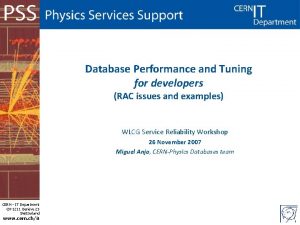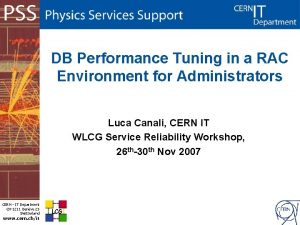Real Life RAC Performance Tuning Arup Nanda Lead




















































- Slides: 52

Real Life RAC Performance Tuning Arup Nanda Lead DBA Starwood Hotels

Who am I Oracle DBA for 13 years and counting l Working on OPS from 1999 l Speak at conferences, write papers, books l © Arup Nanda

Why This Session l I get emails like this: l We are facing performance issues in RAC. What should I do next? l Real Life Advice l Common Issues (with Wait Events) l Dispelling Myths l Formulate a Plan of Attack l Real Life Case Study l proligence. com/downloads. html © Arup Nanda

Our RAC Implementation l Oracle 10 g RAC in March 2004 l Itanium Platform running HP/UX l Oracle 10. 1. 0. 2 Result: Failed l Second Attempt: Dec 2004 – 10. 1. 0. 3 l Result: Failed Again l Third Attempt: March 2005 – 10. 1. 0. 4 l Result: Success! l © Arup Nanda

Challenges l Technology l Lone ranger l A lot of “mystery” and disconnected “facts”! l People l Building a team that could not only deliver; but also sustain the delivered parts l Each day we learned something new l In today’s session: real performance issues we faced and how we resolved them, along with wait events. © Arup Nanda

Why “RAC” Performance? All tuning concepts in single instance applied to RAC as well l RAC has other complexities l l More than 1 buffer cache l Multiple caches – library cache, row cache l Interconnect l Pinging l Global Locking © Arup Nanda

Why RAC Perf Tuning We want to make sure we identify the right problem and go after it l …. not just a problem l © Arup Nanda

Switch Public Interface VIP Service Cache Listener Cache Fusion Instance ASM Clusterware Op Sys Lock Manager OCR Voting Node 1 Instance ASM Clusterware Op Sys Node 2 Interconnect Switch Storage © Arup Nanda

Areas of Concern in RAC More than 1 buffer cache l Multiple caches – library cache, row cache l Interconnect l Global Locking l © Arup Nanda

Cache Issues Two Caches, requires synchronization l What that means: l l. A changed block in one instance, when requested by another, should be sent across via a “bridge” l This bridge is the Interconnect © Arup Nanda

Interconnect Performance Interconnect must be on a private LAN l Port aggregation to increase throughput l l APA l on HPUX If using Gigabit over Ethernet, use Jumbo Frames © Arup Nanda

Checking Interconnect Used l Identify the interconnect used $ oifcfg getif lan 902 172. 17. 1. 0 global cluster_interconnect lan 901 10. 28. 188. 0 global public l Is lan 902 the bonded interface? If not, then set it $ oifcfg setif … © Arup Nanda

Pop Quiz If I have a very fast interconnect, I can perform the same work in multiple node RAC as a single server with faster CPUs. True/False? l Since cache fusion is now write-write, a fast interconnect will compensate for a slower IO subsystem. True/False? l © Arup Nanda

Cache Coherence Times l The time is a sum of time for: l Finding the block in the cache C P l Identifying the master U l Get the block in the interconnect l Transfer speed of the interconnect Interconnect l Latency of the interconnect C l Receive the block by the remote instance P U l Create the consistent image for the user © Arup Nanda

So it all boils down to: l Block Access Cost l l l Lock Management Cost l l l more blocks -> more the time Parallel Query More coordination -> more time Implicit Cache Checks – Sequence Numbers Interconnect Cost l l l Latency Speed more data to transfer -> more the time © Arup Nanda

Hard Lessons In RAC, problem symptoms may not indicate the correct problem! l Example: l l When the CPU is too busy to receive or send packets via UDP, the packets fails and the Clusterware thinks the node is down and evicts it. © Arup Nanda

OS Troubleshooting l OS utilities to troubleshoot CPU issues l top l glance l OS Utilities to troubleshoot process issues: l truss l strace l dbx l pstack © Arup Nanda

Reducing Latency l l A factor of technology TCP is the most latent UDP is better (over Ethernet) Proprietary protocols are usually better l l Hyper. Fabric by HP Reliable Datagram (RDP) Direct Memory Channel Infiniband l l UDP over Infiniband RDP over Infiniband © Arup Nanda

Start with AWR © Arup Nanda

gc current|cr grant 2 -way gc current grant block 2 -way request Session Log Buffer LMS LGWR Instance 2 Instance 1 Database © Arup Nanda

gc current|cr block 2 -way gc gccurrentblock 2 -way request log file sync Session Log Buffer LMS LGWR Instance 2 Instance 1 Database © Arup Nanda

gc current|cr block 3 -way gc current block 3 -way Session Instance 2 Instance 1 Requestor Instance 3 © Arup Nanda Master Holder

RAC related Stats © Arup Nanda

RAC Stats contd. © Arup Nanda

© Arup Nanda

Other GC Block Waits l gc current/cr block lost l Lost l blocks due to Interconnect or CPU gc curent/cr block busy l The consistent read request was delayed, most likely an I/O bottleneck l gc current/cr block congested l Long run queues and/or paging due to memory deficiency. © Arup Nanda

Hung or Slow? l Check V$SESSION for WAIT_TIME l If l 0, then it’s not waiting; it’s hung When hung: l Take a systemstate dump from all nodes l Wait some time l Take another systemstate dump l Check change in values. If unchanged, then system is hung © Arup Nanda

Chart a Plan Rule out the obvious l Start with AWR Report l Start with Top-5 Waits l See if they have any significant waits l … especially RAC related l Go on to RAC Statistics l Base your solution based on the wait event l © Arup Nanda

Rule out the obvious Is interconnect private? l Is interconnect on UDP? l Do you see high CPU? l Do you see a lot of IO bottleneck? l How about memory? l Are the apps spread over evenly? l Do you see lost blocks? l © Arup Nanda

Make Simple Fixes Strongly consider RAID 0+1 l Highest possible number of I/O paths l Use fastest interconnect possible l Use private collision free domain for I/C l Cache and NOORDER sequences l © Arup Nanda

Enterprise Manager © Arup Nanda

Buffer Busy l Cause l Instance wants to bring something from disk to the buffer cache l Delay, due to space not available l Delay, b’coz the source buffer is not ready l Delay, I/O is slow l Delay, b’coz redo log is being flushed l In summary l Log buffer flush -> gc buffer busy © Arup Nanda

Parallel Query l One major issue in RAC is parallel query that goes across many nodes Via Interconnect Slave Instance 1 Slave QC © Arup Nanda Slave Instance 2

Restricting PQ l Define Instance Groups Specify in init. ora prodb 1. instance_groups='pqgroup 1' prodb 2. instance_groups='pqgroup 2' l Specify Instance Groups in Session SQL> alter session set parallel_instance_group = 'pqgroup 1'; © Arup Nanda

Forcing PQ on both Nodes l Define a common Instance Group prodb 1. instance_groups='pqgroup 1‘ prodb 1. instance_groups=‘pq 2 nodes' prodb 2. instance_groups='pqgroup 2' prodb 2. instance_groups='pq 2 nodes' l Specify Instance Groups in Session SQL> alter session set parallel_instance_group = 'pq 2 nodes'; © Arup Nanda

Vital Cache Fusion Views gv$cache_transfer: Monitor blocks transferred by object l gv$class_cache_transfer: Monitor block transfer by class l gv$file_cache_transfer: Monitor the blocks transferred per file l gv$temp_cache_transfer: Monitor the transfer of temporary tablespace blocks l © Arup Nanda

“Hot” Tables l Tables, e. g. Rate Plans l l l Symptoms l l Small Compact blocks High updates High reads gc buffer busy waits Solution l l l Less rows per block High PCTFREE, INITRANS, ALTER TABLE … MINIMIZE RECORDS_PER_BLOCK © Arup Nanda

Hot Sequences l Symptoms: l High waits on Sequence Number latch l High waits on SEQ$ table l Solution: l Increase the cache l Make it NOORDER l Especially AUDSESS$ sequence in SYS, used in Auditing © Arup Nanda

Read Only? Say So. Reading table data from other instances create “gc *” contentions l Suggestion: l l Move Read Only tables to a single tablespace l Make this tablespace Read Only SQL> alter tablespace ROD read only; © Arup Nanda

Partitioning creates several segments for the same table (or index) l => more resources l => less contention l © Arup Nanda

Monotonically Increasing Index l Problem: l “Reservation ID”, a sequence generated key l Index is heavy on one side l Symptoms l Buffer busy waits l Index block spilts l Solutions: l Reverse key indexes l Hash partitioned index (even if the table is not partitioned) 10 g. R 2 © Arup Nanda

Library Cache In RAC, Library Cache is global l So, parsing cost is worse than non-RAC l Solutions: l l Minimize table alters, drops, creates, truncates l Use PL/SQL stored programs, not unnamed blocks © Arup Nanda

Log Files l l In 10 g R 2, the log files are in a single location: $CRS_HOME/log/<Host>/… Ê racg Ê crsd Ê cssd Ê evmd Ê client Ê cssd/oclsmon l $ORACLE_HOME/racg/dump © Arup Nanda

Case Study © Arup Nanda

Diagnosis ifconfig -a shows no congestion or dropped packets l Top shows 1% idle time on node 2 l Top processes l l LMS l and LMD And, several Netbackup processes © Arup Nanda

Further Diagnosis l SQL: select * from v$instance_cache_transfer where class = 'data block' and instance = 1; l Output: INSTANCE CLASS CR_BLOCK CR_BUSY ------------------CR_CONGESTED CURRENT_BLOCK CURRENT_BUSY CURRENT_CONGESTED ----------------1 data block 162478682 5097149 477721 347917908 2950144 16320267 l After sometime: INSTANCE CLASS CR_BLOCK CR_BUSY ------------------CR_CONGESTED CURRENT_BLOCK CURRENT_BUSY CURRENT_CONGESTED ----------------1 data block 162480580 5097185 477722 347923719 2950376 16320269 © Arup Nanda See increases

l Diagnosis: l CPU starvation by LMS/D processes caused GC waits. l Solution: l Killed the Netbackup processes l LMD and LMS got the CPU © Arup Nanda

Increasing Interconnect Speed l Faster Hardware l l l NIC settings l l l Duplex Mode Highest Top Bit Rate TCP Settings l l Gigabit Ethernet; not Fast Infiniband, even if IP over IB Flow Control Settings Network Interrupts for CPU Socket Receive Buffer LAN Planning l l Private LANs Collision Domains © Arup Nanda

High Speed Interconnects Oracle will support RDS over Infiniband l http: //oss. oracle. com/projects/rds/ l On 10 Gig Ethernet as well l © Arup Nanda

In summary: Planning Adequate CPU, Network, Memory l Sequences – cache, noorder l Tablespaces read only l Un-compact small hot tables l Keep undo and redo on fastest disks l Avoid full table scans of large tables l Avoid DDLs and unnamed PL/SQL blocks l © Arup Nanda

In summary: Diagnosis Start with AWR l Identify symptoms and assign causes l Don’t get fooled by “gc” waits as interconnect issues l Find the correlation between “dropped” packets in network, CPU issues from sar and “gc buffer lost” in sysstat reports. l © Arup Nanda

Thank You! Download from: proligence. com/downloads. html © Arup Nanda
 Arup nanda exadata
Arup nanda exadata Arup guha
Arup guha Arup guha rate my professor
Arup guha rate my professor Arup guha
Arup guha Arup guha
Arup guha Arup
Arup Arup
Arup Thomson tuning
Thomson tuning Sql server 2005 performance monitor
Sql server 2005 performance monitor Mainframe tuning
Mainframe tuning Oracle tuning tutorial
Oracle tuning tutorial Glusterfs tuning
Glusterfs tuning Apache performance tuning
Apache performance tuning Abap performance tuning
Abap performance tuning Moodle
Moodle Frog sql
Frog sql Ssas performance tuning
Ssas performance tuning Sshfs vs nfs
Sshfs vs nfs Maximo performance tuning
Maximo performance tuning Apache performance tuning
Apache performance tuning Mysql huge pages
Mysql huge pages Database performance tuning and query optimization
Database performance tuning and query optimization Solarwinds performance tuning
Solarwinds performance tuning Harrison performance and tuning
Harrison performance and tuning Jörg stryk
Jörg stryk Data warehouse performance tuning
Data warehouse performance tuning Terminal server performance tuning
Terminal server performance tuning Walker performance tuning
Walker performance tuning Informix performance tuning
Informix performance tuning Frequency dependence of dielectric constant
Frequency dependence of dielectric constant Examples of real life problems involving polynomials
Examples of real life problems involving polynomials Tìm lớp tương đương
Tìm lớp tương đương What is the sacred rac
What is the sacred rac Codul rac
Codul rac Rac assessment
Rac assessment Rac exam questions
Rac exam questions Rac charging stations
Rac charging stations Rac 101
Rac 101 Rac periodic maintenance inspection
Rac periodic maintenance inspection Oracle rac
Oracle rac Logic vị từ là gì
Logic vị từ là gì Thung rac
Thung rac Rac timeline
Rac timeline Rac theory
Rac theory Bridge rac
Bridge rac Rac prototype
Rac prototype Ash report for rac
Ash report for rac Rac servicing
Rac servicing Oci visio stencils
Oci visio stencils Oracle sharding
Oracle sharding Mc rac
Mc rac El raco fib
El raco fib Acesso central femoral
Acesso central femoral
